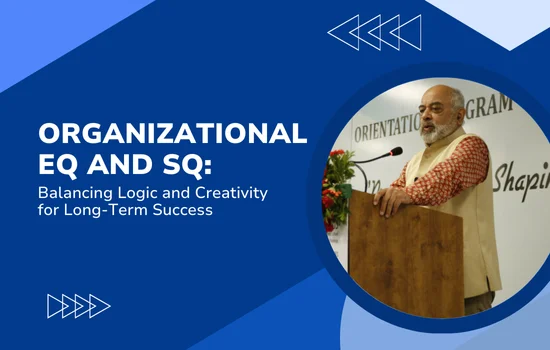
For decades, intelligence and technical skills have been considered the primary drivers of success. Organizations have built their foundations on structured processes, data-driven decisions, and analytical thinking. But in today’s fast-evolving world, this left-brain-dominated approach is no longer enough.
True, sustainable success—whether for individuals or organizations—requires a balance between logic and creativity, analysis and intuition, structure and adaptability. This is where Emotional Quotient (EQ) and Spiritual Quotient (SQ) come into play. While IQ ensures efficiency, EQ fosters collaboration, and SQ strengthens purpose and long-term vision.
In this blog, I’ll explore how organizations can activate both hemispheres of the brain—leveraging analytical intelligence while fostering creativity, empathy, and values-driven leadership—to build resilient, future-ready teams.
The Brain and Its Two Halves: Lessons for Organizations
The human brain is divided into two hemispheres, each with distinct functions. The left brain is logical, analytical, and systematic. The right brain, on the other hand, is creative, abstract, and intuitive. Just like individuals benefit from engaging both sides of their brain, organizations must aim to do the same.
Unfortunately, most organizations today are heavily left-brain oriented. They excel at creating systems, structures, and result-oriented processes, ensuring accountability at every step. But these organizations often overlook right-brain activities- creativity, innovation, and emotional connection.
Take Google, for example, a company renowned for fostering creativity and right-brain engagement among its workforce. This isn’t just a feel-good initiative; it’s a strategic move that aligns with the modern understanding of organizational effectiveness. A company that ignores the right brain, eventually ignores the EQ and SQ, which leads to eventual decline.
The Source of Organizational EQ and SQ
Where does an organization derive its EQ and SQ? From its people. Systems, processes, and technology can streamline operations, but they cannot provide an organization with emotional intelligence or spiritual depth. It is the workforce, its values, emotional resilience, and creative capacity, that serves as the foundation of EQ and SQ.
This brings us to an important analogy. The human DNA comprises 23 pairs of chromosomes and over 23,000 genes, which are passed down through generations. However, behavior is not genetic. It is shaped by experiences and environment. Similarly, an organization’s behavior, its culture, is a product of its people and their interactions, not just its structural framework.
Values vs. Culture: Understanding the Difference
Values are universal and steadfast. They are not determined by genetics or trends; rather, they are upheld by society as a whole. Culture, however, is more specific; it reflects the unique identity of a community or organization.
Consider the Indian Army, a massive organization with over 1.1 million soldiers. It is divided into various units and regiments, each with its own culture—be it the Madras Regiment, the Punjab Regiment, or the Maratha Regiment. Despite these cultural differences, the Army operates on a shared value system that binds it together. This strong commitment to core values enables the Army to achieve extraordinary feats.
Similarly, for organizations, values form the spiritual core. They are lived by the right brain and contribute to the organization’s SQ. Spirituality in this context is not about religion; it is about being deeply connected to the organization’s values and ensuring those values are reflected in every action.
Building an EQ and SQ-Driven Organization
To create an organization with strong EQ and SQ, the leaders must ensure that values are clearly defined, understood, and lived by every member of the workforce. This involves:
- Promoting Creativity and Emotional Intelligence
Organizations must move beyond purely logical, left-brain processes. Encouraging creativity, empathy, and emotional resilience among employees is essential for fostering innovation and adaptability. - Integrating Values into the Culture
Values should not be mere statements on a wall. They must be actively practiced and reflected in the organization’s decisions, policies, and interactions. - Balancing Logic with Intuition
While data-driven decisions and systematic processes are important, leaders must also trust intuition and encourage innovative thinking. - Investing in People
An organization’s greatest asset is its people. Investing in their personal and professional growth not only enhances EQ and SQ but also contributes to long-term success.
The Path Forward
The left-brain-dominated approach of the industrial era is no longer enough. The organisations must embrace the new shift, valuing EQ and SQ to ensure long-term success.When organizations prioritize EQ and SQ, they move beyond seeing people as resources to recognizing them as their greatest asset.
As a person with experience, I can confidently say that the strength of any team, be it a regiment or a corporation, lies in its people.
About Cdr. Girish Konkar (Retd.)
Cdr. Girish Konkar (Retd.) is a seasoned leadership coach, keynote speaker, and corporate mentor with over two decades of experience in leadership development. A former officer in the Indian Navy, he brings a unique blend of military precision, strategic thinking, and real-world leadership insights to his coaching. Through his expertise, he helps individuals and organizations cultivate resilience, adaptability, and high-performance mindsets. Cdr. Konkar is passionate about transforming leaders by integrating discipline, emotional intelligence, and values-driven leadership into modern business environments.





